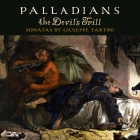While Andrew Manze’s (scintillating) 1997 recording of Tartini’s famous “Devil’s Trill” sonata (Harmonia Mundi) makes a fascinating study of the work’s possibilities as an unaccompanied showpiece (an approach Manze justifies with documentary evidence from Tartini himself), this one makes a convincing case for the same work’s room-filling power as a collaborative effort (the way it’s usually presented), the soloist’s virtuoso pyrotechnics supported by the continuo’s added depth (7-string bass viol) and harmonic texture (harpsichord and archlute).
Of course the violin part, inspired by the composer’s dream in which the devil appeared in his bedroom and played “a sonata so unusual and so beautiful, performed with such mastery and intelligence, on a level I had never before conceived was possible”, is an impressive creation truly worthy of its diabolical vision; yet for today’s most versatile, rigorously trained violinists, its technical difficulties are not so formidable as they may have been to generations past. And indeed, Rodolfo Richter (and his bright, bold-voiced 1674 Guarneri) is more than capable of generating the necessary sparks, delicate turns and swift runs, sombre, dark-toned moods, commanding multiple-stops and double-note trills, and dazzling fireworks.
This is not only true of the “Devil’s Sonata”, but also throughout Francesco Veracini’s A major sonata Op. 1 No. 7, whose final Allegro is itself worth the price of the disc. (Veracini was an important influence on Tartini as a young performer, so this work is included to provide “an idea of Veracini’s style”.) Other examples of Tartini’s non-devil-inspired compositions, including two individual movements from a sonata and a viol concerto, make for a very engaging program of music that almost any listener will enjoy–for the tunes, the energetic rhythms, and of course the virtuoso violin playing.
My only complaint is that the continuo is often too big, too present, its full-bodied sound leaving us to hear less violin than we should–and Richter’s tendency to drop down at ends of phrases allows those notes to be overwhelmed by the other instruments. Nevertheless, in the slow movements, especially where archlute accompanies the violin, and in the numerous “big”, fast, and wilder sections of these works, there’s nothing to say but, “This is fun!”, and these Palladians (formerly the Palladian Ensemble) really know how to make an impressive, entertaining show. Strongly recommended.
































